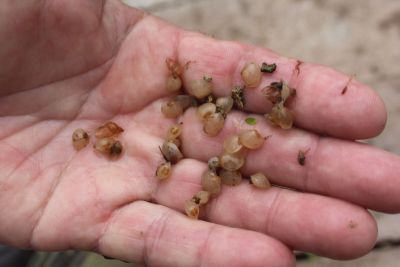Sphaeriidae
Sphaeriidae (also known as pea clams or fingernail clams) is a family of small, freshwater bivalves in the order Sphaeriida and consists of 10 genera with 154 species. They are both hermaphrodites and ovoviviparous, giving birth to young that resemble miniature versions of adults [1].

| |
| Kingdom: | Animalia |
|---|---|
| Phylum: | Mullusca |
| Class: | Bivalvia |
| Order: | Sphaeridda |
| Family: | Sphaerioidea |
| Source: Goliad Farms [8] | |
Identification
Shells are usually rounded or oval, but some species have more of a trigonal or tetragonal shape. The colors range from pale yellow or white to chestnut or dark brown [2]. The size can range from <3mm in the smallest species (pisidium punctatum) to approximately 25mm for the largest (spharium simile) [2]. They can be easily missed in the field stream studies because of their small size. Juvenile shells are more yellow. Sphaeriidaes can live up to 3 years and mature at 4mm [3].
Habitat and Range
Native in Eurasia [3]. In North America, native species of sphaeriids have a broad distribution, often ranging from the Atlantic to the Pacific coast. They can be found in aquatic habitats, from large lakes and rivers to springs, bogs, and vernal pools. But unlike mussels, Sphaeriidae will not burrow very deep into the sediment (<3mm). They usually occur in large numbers [4]. They are most common in the sandy or muddy sediments of lakes, slow-flowing streams, seepage, and swamp habitats [5].
Life History
Shariid life history traits include their viviparous reproduction. This means they brood their young internally. The embryos develop within specialized chambers, supplied with maternal nutrients, and are released as fully formed miniature adults. Even though adult sphaeriids are the smallest of all North American freshwater bivalves, they release the largest young. The average birth shell length ranged from 0.6 to 4.15 mm. Seasonal water availability fluctuations and hypoxia associated with their habitats have also influenced the development of juveniles, as they are more susceptible to environmental stress. This can cause high adult mortality. They devote more energy to reproduction than other freshwater bivalves. The term “bet-hedging” has been used to describe the mixture of r- and K-selective traits allowing for increased fitness in environments with periodic, predictable stress [6].

Research
Since sphaeriids are hermaphrodites, they have an invasive dispersal pattern, as only one individual is theoretically needed to establish a population. Mechanisms for aiding in dispersal include juveniles clamping down on parts of another organism, such as aquatic insects, water fowl, and salamanders[7]. They effectively use the other organism as transport to a new environment where they can detach.
References
- Allaby, Michael. A Dictionary of Zoology, Oxford University Press, Incorporated, 2020. ProQuest Ebook Central, https://ebookcentral-proquest-com.gate.lib.buffalo.edu/lib/buffalo/detail.action?docID=6230105.
- Frankiewicz, A. (2018). Guideline for field collecting and preserving Sphaeriidae clams, for DNA and Taxonomic research. https://www.greatlakeswetlands.org/docs/QAPPs_SOPs/SOP%20for%20collecting%20fingernail%20clams.pdf
- European fingernail clam (Sphaerium corneum) - Species Profile. (n.d.). USGS Nonindigenous Aquatic Species Database. https://nas.er.usgs.gov/queries/FactSheet.aspx?speciesID=131
- Identification and ecology of Australian freshwater invertebrates. (n.d.-b). https://www.mdfrc.org.au/bugguide/display.asp?class=22&subclass=&order=59&Couplet=0&Type=3
- Fingernail clams (Sphaeriidae). (n.d.). Manaaki Whenua. https://www.landcareresearch.co.nz/tools-and-resources/identification/freshwater-invertebrates-guide/identification-guide-what-freshwater-invertebrate-is-this/no-jointed-legs/molluscs/bivalves/fingernail-clams-sphaeriidae/
- Sphaeriidae. (n.d.). Science Direct. https://www.sciencedirect.com/topics/agricultural-and-biological-sciences/sphaeriidae
- Club, O. F. (1982). The Canadian field-naturalist. https://www.biodiversitylibrary.org/page/28008061#page/230/mode/1up
- Charles. (2017, February 1). Fingernail Clams, Sphaerium corneum. Goliad Farms. https://goliadfarms.com/fingernail-clams-sphaerium-corneum/